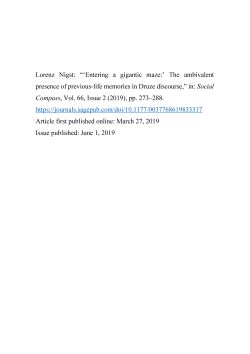


According to the Druze notion of transmigration (taqammuṣ), whenever someone dies, his or her soul moves into the body of a newborn Druze of the same sex. While this makes the Druze feel that they belong together in a more fundamental way because they are ‘born in each other’s houses’ (Oppenheimer), it is more ambivalent the moment children start to ‘speak’ about previous lives in another family. Allowing the ‘return’ of someone lost to death and potentially bringing two such houses in closer relation, ‘speaking’ also requires coming to terms with conflicting belonging.

…
Résumé
Selon la notion druze de transmigration (taqammuṣ), quand une personne meurt, son âme entre dans le corps d'un nouveau-né druze du même sexe. Bien que cela donne aux druzes le sentiment d'appartenir à une communauté plus fondamentale parce qu'ils sont « nés dans la maison de l'autre « (Oppenheimer), la situation devient plus ambivalente quand enfants commencent à « parler » de leurs vies antérieures, ce qui rapproche potentiellement ces deux maisons l’une de l’autre